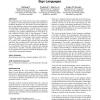Free Online Productivity Tools
i2Speak
i2Symbol
i2OCR
iTex2Img
iWeb2Print
iWeb2Shot
i2Type
iPdf2Split
iPdf2Merge
i2Bopomofo
i2Arabic
i2Style
i2Image
i2PDF
iLatex2Rtf
Sci2ools
CHI
2005
ACM
2005
ACM
From creating virtual gestures to "writing" in sign languages
Sign languages have been proven to be natural languages, as capable of expressing human thoughts and emotions as traditional languages are. The distinct visual and spatial nature of sign languages seems to be an insurmountable barrier for developing a sign language "word processor". However, we argue that with the advancement of computer graphics technology and graphical implementations of linguistic results obtained from the study of sign languages, "writing" in a sign language should not be difficult. We have pursued exploratory work in constructing virtual gestures, applying hand constraints to facilitate the creation of natural gestures, and combining these gestures into meaningful American Sign Language (ASL) parts that follow the ASL Movement-Hold model. The results, although preliminary, are encouraging. We believe that effective sign language composition is possible with the implementation of easyto-use graphical user interfaces and the development of speci...
CHI 2005 | Human Computer Interaction | Keywords Sign Language | Sign Language Composition | Sign Languages |
| Added | 30 Nov 2009 |
| Updated | 30 Nov 2009 |
| Type | Conference |
| Year | 2005 |
| Where | CHI |
| Authors | Beifang Yi, Frederick C. Harris Jr., Sergiu M. Dascalu |
Comments (0)

